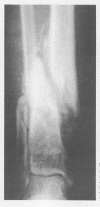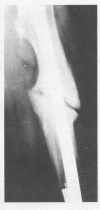Abstract
Nonunion is a fairly common complication of fracture management, with an overall rate of about 3% for the skeleton as a whole and 9% for the tibia. High-energy injury fractures have a nonunion rate as high as 75%. Other factors that may lead to nonunion are inappropriate treatment, infection, and preexisting disease. The diagnosis of nonunion is based largely on clinical examination. Plain radiographs and tomograms, computed tomograms, and contrast imaging may be used to confirm nonhealing. Radionuclide imaging can help determine the presence of infection, an impaired blood supply, or impaired osteogenic activity at the fracture site. The treatment of ununited fractures is based on the principles of good fracture management: adequate immobilization, asepsis and soft tissue cover, osteoconduction (bone contact), osteoinduction (stimulation of bone growth), and metabolic well-being. New modalities for osteoinduction are promising adjuncts to standard treatment, the autogenous bone graft, but conclusive proof of efficacy in humans does not yet exist.
Full text
PDF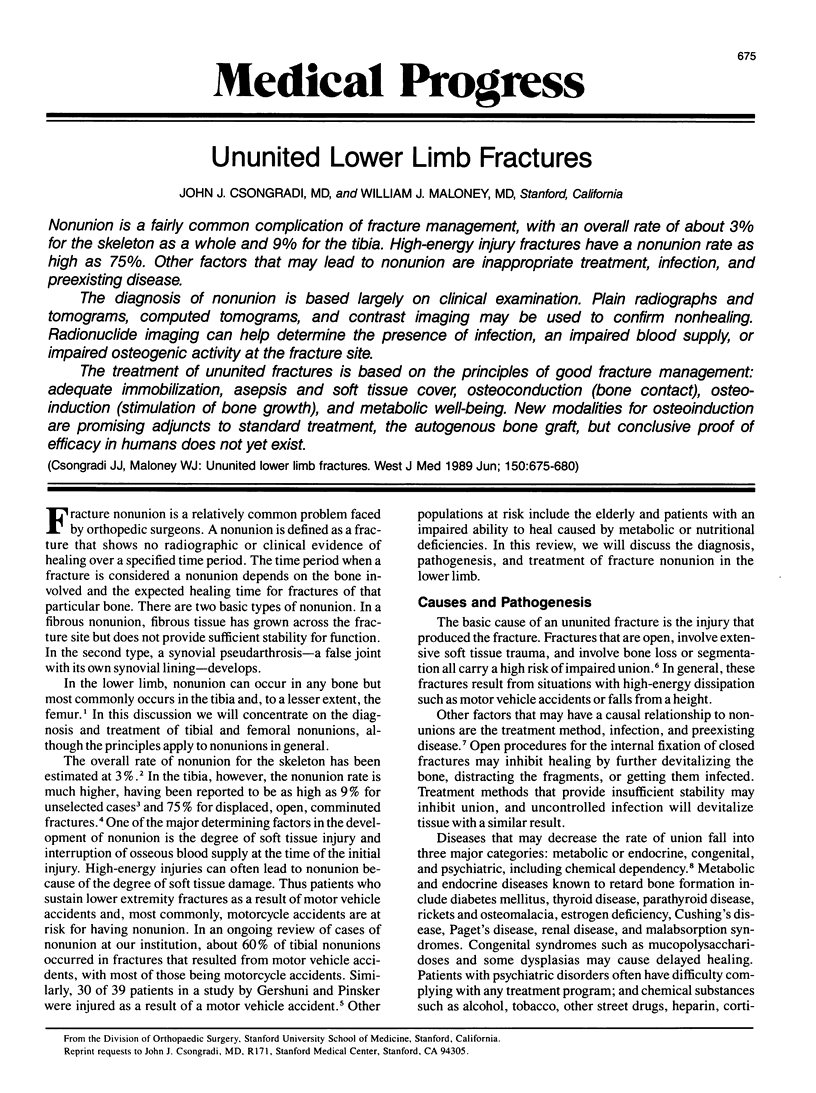
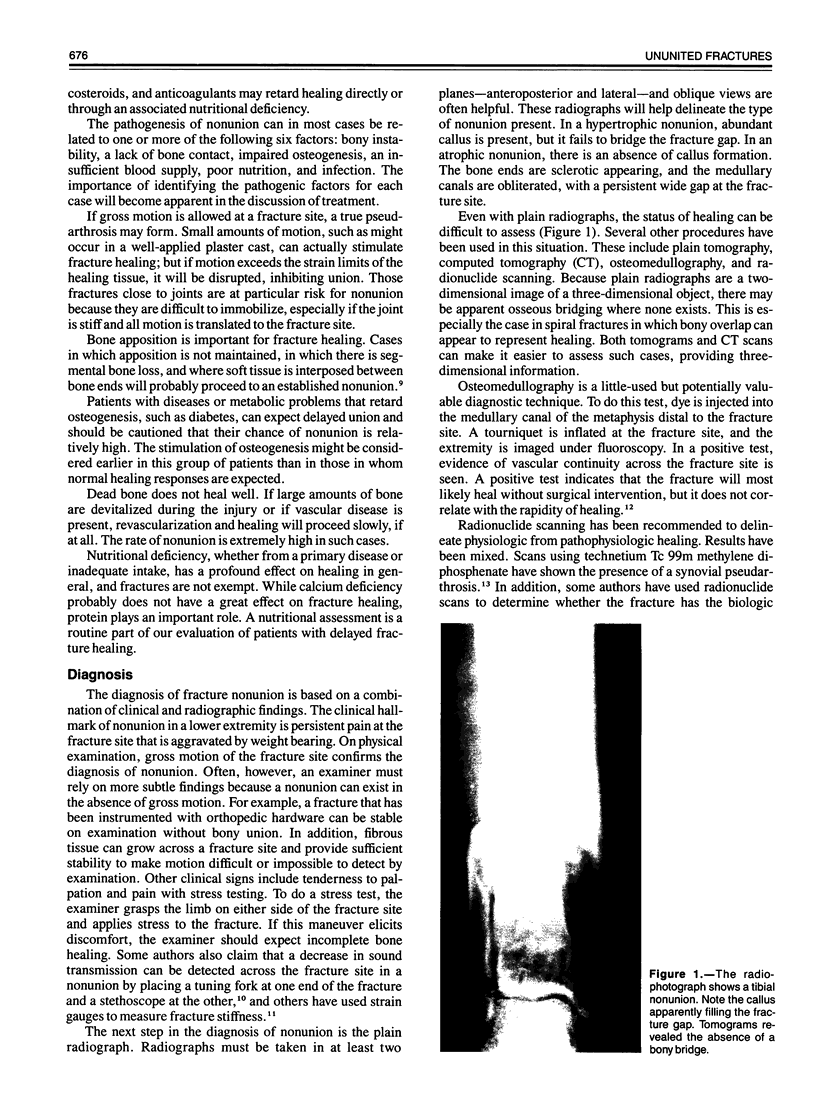
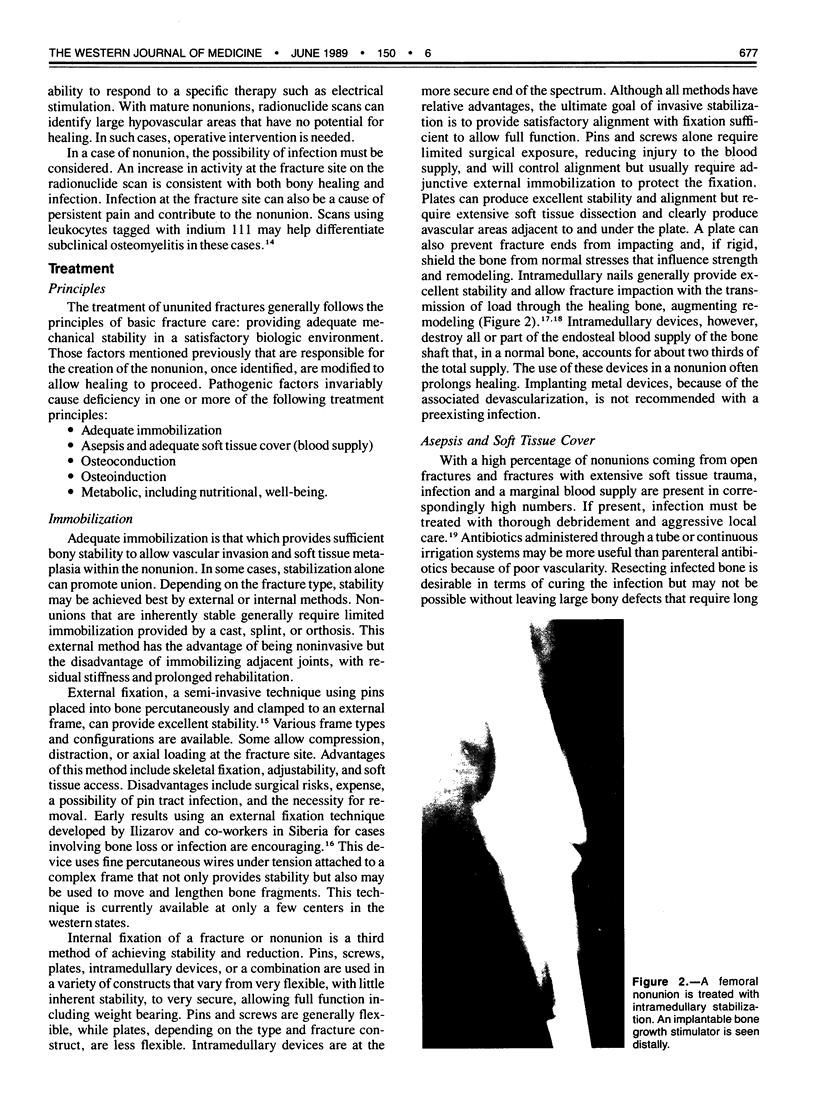
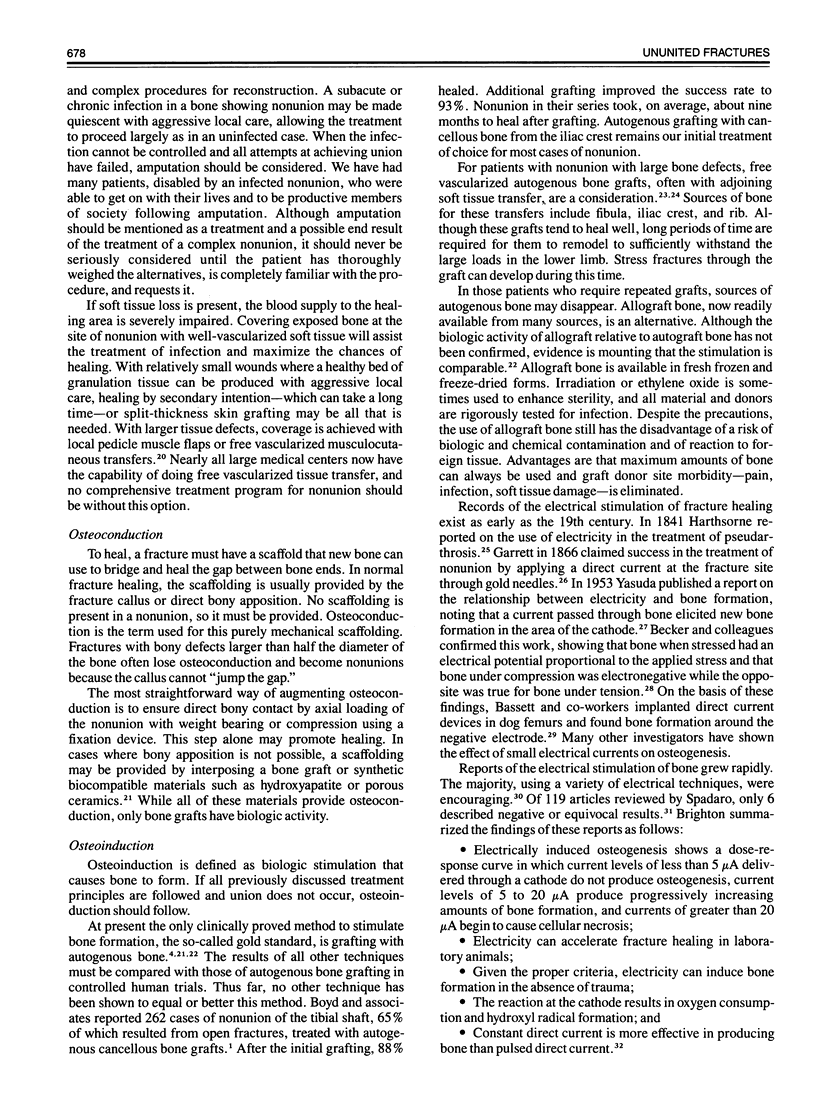
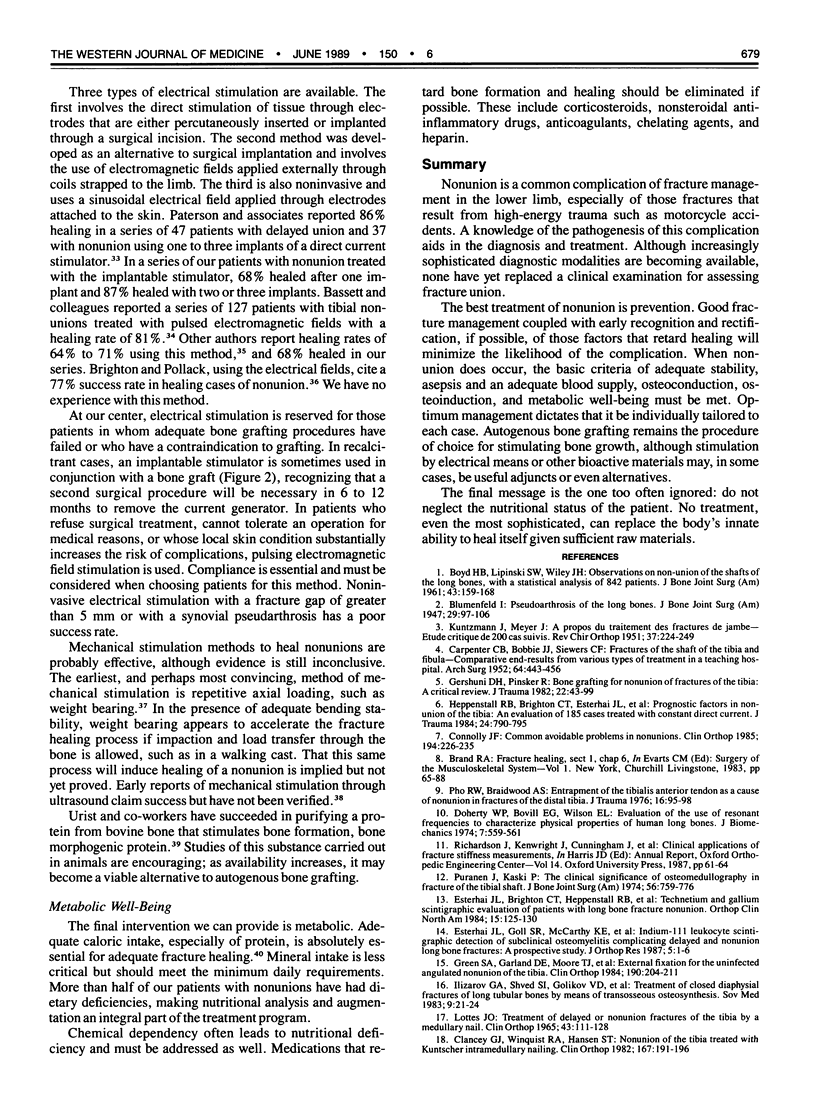
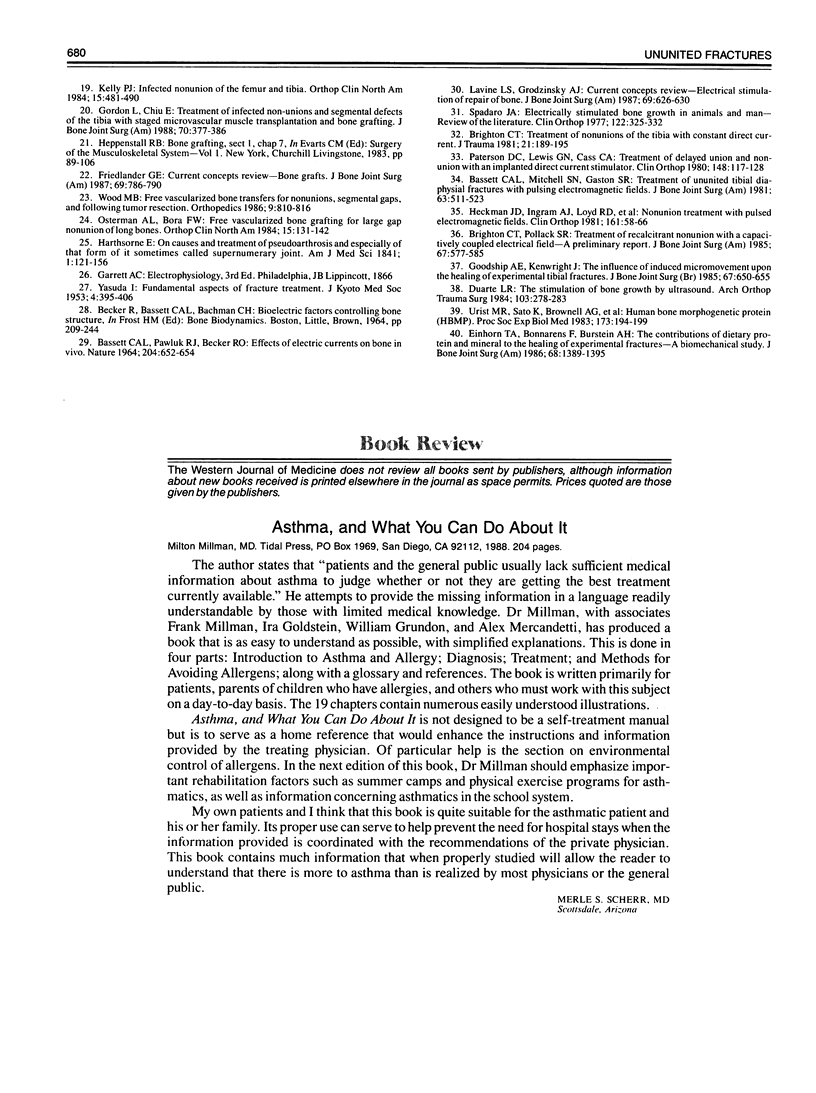
Images in this article
Selected References
These references are in PubMed. This may not be the complete list of references from this article.
- BASSETT C. A., PAWLUK R. J., BECKER R. O. EFFECTS OF ELECTRIC CURRENTS ON BONE IN VIVO. Nature. 1964 Nov 14;204:652–654. doi: 10.1038/204652a0. [DOI] [PubMed] [Google Scholar]
- Bassett C. A., Mitchell S. N., Gaston S. R. Treatment of ununited tibial diaphyseal fractures with pulsing electromagnetic fields. J Bone Joint Surg Am. 1981 Apr;63(4):511–523. [PubMed] [Google Scholar]
- Brighton C. T., Pollack S. R. Treatment of recalcitrant non-union with a capacitively coupled electrical field. A preliminary report. J Bone Joint Surg Am. 1985 Apr;67(4):577–585. [PubMed] [Google Scholar]
- Brighton C. T. Treatment of nonunion of the tibia with constant direct current (1980 Fitts Lecture, A.A.S.T.). J Trauma. 1981 Mar;21(3):189–195. doi: 10.1097/00005373-198103000-00001. [DOI] [PubMed] [Google Scholar]
- CARPENTER E. B., DOBBIE J. J., SIEWERS C. F. Fractures of the shaft of the tibia and fibula; comparative end-results from various types of treatment in a teaching hospital. AMA Arch Surg. 1952 Apr;64(4):443–456. doi: 10.1001/archsurg.1952.01260010459004. [DOI] [PubMed] [Google Scholar]
- Clancey G. J., Winquist R. A., Hansen S. T., Jr Nonunion of the tibia treated with Küntscher intramedullary nailing. Clin Orthop Relat Res. 1982 Jul;(167):191–196. [PubMed] [Google Scholar]
- Connolly J. F. Common avoidable problems in nonunions. Clin Orthop Relat Res. 1985 Apr;(194):226–235. [PubMed] [Google Scholar]
- Dhoerty W. P., Bovill E. G., Wilson E. L. Evaluation of the use of resonant frequencies to characterize physical properties of human long bones. J Biomech. 1974 Nov;7(6):559–561. doi: 10.1016/0021-9290(74)90090-6. [DOI] [PubMed] [Google Scholar]
- Einhorn T. A., Bonnarens F., Burstein A. H. The contributions of dietary protein and mineral to the healing of experimental fractures. A biomechanical study. J Bone Joint Surg Am. 1986 Dec;68(9):1389–1395. [PubMed] [Google Scholar]
- Esterhai J. L., Jr, Brighton C. T., Heppenstall R. B., Alavi A., Mandell G. A. Technetium and gallium scintigraphic evaluation of patients with long bone fracture nonunion. Orthop Clin North Am. 1984 Jan;15(1):125–130. [PubMed] [Google Scholar]
- Esterhai J. L., Jr, Goll S. R., McCarthy K. E., Velchik M., Alavi A., Brighton C. T., Heppenstall R. B. Indium-111 leukocyte scintigraphic detection of subclinical osteomyelitis complicating delayed and nonunion long bone fractures: a prospective study. J Orthop Res. 1987;5(1):1–6. doi: 10.1002/jor.1100050102. [DOI] [PubMed] [Google Scholar]
- Forssell H., Aro H., Aho A. J. Experimental osteosynthesis with liquid ethyl cyanacrylate polymerized with ultrasound. Arch Orthop Trauma Surg. 1984;103(4):278–283. doi: 10.1007/BF00387334. [DOI] [PubMed] [Google Scholar]
- Friedlaender G. E. Bone grafts. The basic science rationale for clinical applications. J Bone Joint Surg Am. 1987 Jun;69(5):786–790. [PubMed] [Google Scholar]
- Gershuni D. H., Pinsker R. Bone grafting for nonunion of fractures of the tibia: a critical review. J Trauma. 1982 Jan;22(1):43–49. doi: 10.1097/00005373-198201000-00008. [DOI] [PubMed] [Google Scholar]
- Goodship A. E., Kenwright J. The influence of induced micromovement upon the healing of experimental tibial fractures. J Bone Joint Surg Br. 1985 Aug;67(4):650–655. doi: 10.1302/0301-620X.67B4.4030869. [DOI] [PubMed] [Google Scholar]
- Gordon L., Chiu E. J. Treatment of infected non-unions and segmental defects of the tibia with staged microvascular muscle transplantation and bone-grafting. J Bone Joint Surg Am. 1988 Mar;70(3):377–386. [PubMed] [Google Scholar]
- Green S. A., Garland D. E., Moore T. J., Barad S. J. External fixation for the uninfected angulated nonunion of the tibia. Clin Orthop Relat Res. 1984 Nov;(190):204–211. [PubMed] [Google Scholar]
- Heckman J. D., Ingram A. J., Loyd R. D., Luck J. V., Jr, Mayer P. W. Nonunion treatment with pulsed electromagnetic fields. Clin Orthop Relat Res. 1981 Nov-Dec;(161):58–66. [PubMed] [Google Scholar]
- Heppenstall R. B., Brighton C. T., Esterhai J. L., Jr, Muller G. Prognostic factors in nonunion of the tibia: an evaluation of 185 cases treated with constant direct current. J Trauma. 1984 Sep;24(9):790–795. [PubMed] [Google Scholar]
- Ilizarov G. A., Shved S. I., Golikov V. D., Karagodin G. E. Lechenie zakrytykh diafizarnykh perelomov dlinnykh trubchatykh kostei metodom chreskostnogo osteosinteza. Sov Med. 1983;(9):21–24. [PubMed] [Google Scholar]
- KUNTZMANN J., MEYER J. A propos du traitement des fractures de jambe; étude critique de 200 cas suivis. Rev Chir Orthop Reparatrice Appar Mot. 1951 Jul-Sep;37(3-4):224–249. [PubMed] [Google Scholar]
- Kelly P. J. Infected nonunion of the femur and tibia. Orthop Clin North Am. 1984 Jul;15(3):481–490. [PubMed] [Google Scholar]
- Lavine L. S., Grodzinsky A. J. Electrical stimulation of repair of bone. J Bone Joint Surg Am. 1987 Apr;69(4):626–630. [PubMed] [Google Scholar]
- Lottes J. O. Treatment of delayed or nonunion fractures of the tibia by a medullary nail. Clin Orthop Relat Res. 1965 Nov-Dec;43:111–128. doi: 10.1097/00003086-196500430-00012. [DOI] [PubMed] [Google Scholar]
- Osterman A. L., Bora F. W. Free vascularized bone grafting for large-gap nonunion of long bones. Orthop Clin North Am. 1984 Jan;15(1):131–142. [PubMed] [Google Scholar]
- Paterson D. C., Lewis G. N., Cass C. A. Treatment of delayed union and nonunion with an implanted direct current stimulator. Clin Orthop Relat Res. 1980 May;(148):117–128. [PubMed] [Google Scholar]
- Pho R. W., Braidwood A. S. Entrapment of the tibialis anterior tendon as a cause of nonunion in fractures of the distal tibia. J Trauma. 1976 Feb;16(2):95–98. doi: 10.1097/00005373-197602000-00003. [DOI] [PubMed] [Google Scholar]
- Puranen J., Kaski P. The clinical significance of osteomedullography in fractures of the tibial shaft. J Bone Joint Surg Am. 1974 Jun;56(4):759–776. [PubMed] [Google Scholar]
- Spadaro J. A. Electrically stimulated bone growth in animals and man. Review of the literature. Clin Orthop Relat Res. 1977 Jan-Feb;(122):325–332. [PubMed] [Google Scholar]
- Urist M. R., Sato K., Brownell A. G., Malinin T. I., Lietze A., Huo Y. K., Prolo D. J., Oklund S., Finerman G. A., DeLange R. J. Human bone morphogenetic protein (hBMP). Proc Soc Exp Biol Med. 1983 Jun;173(2):194–199. doi: 10.3181/00379727-173-41630. [DOI] [PubMed] [Google Scholar]
- Wood M. B. Free vascularized bone transfers for nonunions, segmental gaps, and following tumor resection. Orthopedics. 1986 Jun;9(6):810–816. doi: 10.3928/0147-7447-19860601-07. [DOI] [PubMed] [Google Scholar]



